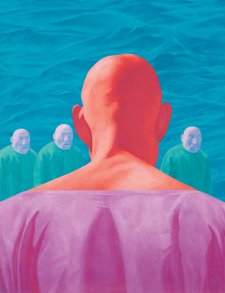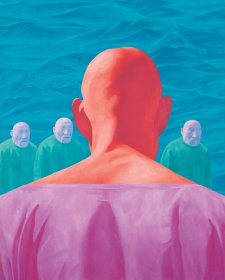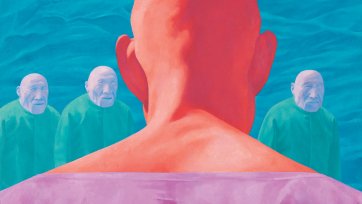“Yu Hong ... is among the most highly-regarded figurative painter, widely celebrated for her intimate, unpretentious, and highly tactile work. She and a small group of colleagues became known as the "New Generation" artists, known for their highly personal figurative works. Yu Hong graduated from the oil painting department at the Central Academy of Fine Arts in Beijing in 1995 and currently teaches there.”
(artzinechina.com)
Context and comment
“Yu Hong’s She – Unemployed Girl (2003), a triptych with two photos flanking a painting frames similar preoccupations in a more complex way. Incongruity is the theme that runs through each of the three panels. The pair of photographs shows the same woman in gaudy pink bride gown against the humdrum environments of everyday life. The central panel depicts a young mother, fashionably attired, forms symmetry with what appears to be either her mother or mother-in-law; both seated in sofas. The incongruity of the situation is palpable. The sets of sofas do not match, yet the two sets are improbably arranged together as a set. The two walls are just as disjoined: one festooned with hangings of artificial plants; the other covered with a landscape painting. The furnishings and their symmetrical setup recall the level of formality and gravitas often on display in photographs of national leaders receiving distinguished foreign visitors in the Great Hall of People. The disjuncture among different furnishings and decorations mildly mocks the ludicrousness of the untenable formality—not to mention the unease with which the familial relationship is impossibly displaced into this grandiose milieu. The mop leaning against the wall ultimately deflates whatever pomposity propped up here. The triptych maps out well the confusion and comedy arising out of the rapidly reconfigured life and space in contemporary China.”
(Wang, Three decades: Themes, 2012)
“The effects of social and economic reforms on the lives of women inspired a series of portraits by Yu Hong (b. 1966) of writers, artists, students, professors, and entrepreneurs. She – Unemployed girl 2003, an irregular-shaped multi-panel, multi-media work, appears to emphasise the untidiness of the challenges and opportunities afforded by social change, suggesting the reality/unreality of women’s lives.”
(Roberts C. , Go Figure! Contemporary Chinese Portraiture, 2012)
Further reading
Review by Madeleine O’Dea
www.longmarchspace.com
Wu Hung. (1999). Transience; Chinese experimental art at the end of the twentieth century. Chicago: The David and Alfred Smart Museum. pp. 142 – 147
Fan Di'an, (2011). A New Horizon; Contemporary Chinese Art. (F. Di'an, Ed.) Canberra, ACT, Australia: National Museum of Australia. Pp. 112
Roberts, C. (2012). Go figure! Contemporary Chinese Portraiture. (D. C. Roberts, Ed.) Canberra and Sydney, Australia: National Portrait Gallery and The Sherman Contemporary Art Foundation.















